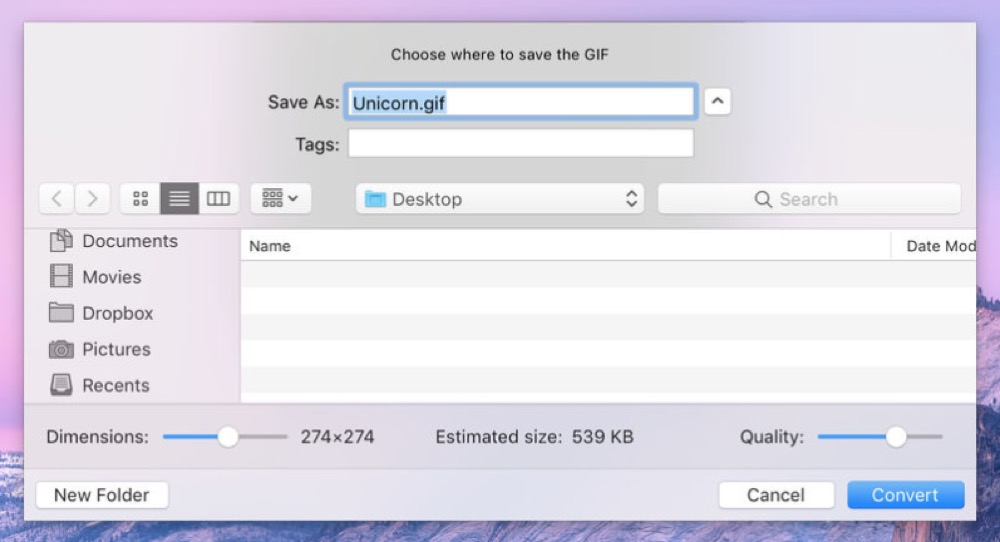

gz and was created by the "compress" tool, released in 1984. at the cost of a vastly increased complexity (and higher CPU load during playback).īut that's not the main topic of this thread. I'm pretty sure webp animations are way smaller than my animated GIFs (maybe half the size). GIF and JPEG still rule because there are a gazillion GIF/JPEG tools and every device supports those formats. Yes, it's a bit better than GIF/PNG/JPEG in most aspects but not to the extent that it brings a true and obvious advantage to everyday users. In my opinion, webp won't achieve any significance because it just doesn't have any killer feature.
GIFSKI DLL MP4
I don't think webp/webm will replace animated GIFs - the only "competitor" is MP4 which is already supported by pretty much every browser (incl. Unfortunately it's quite likely that several GIF decoders require the initial Clear code so I'm thinking of adding several compatibility -p always implies -n The visual effect is that the first line is one pixel too short and its last pixel (right-most column) is the first pixel of the second line - then the second line is missing a pixel because it was used for the first line and so on.

However, it's already a pixel in flexiGIF's output. XnView seems to always assume that the first token of the LZW bitstream is the Clear code and skips it. However, this switch also resets the dictionary as soon as it's full, so it costs more than just a byte per file:ĪiZ's FT2 animated GIF with parameter -a=128 (chosen instead of -a=1 to speed up encoding, takes about a minute)Īnd with parameters -a=128 -c (note the added "compatibility switch" -c) If you use flexiGIF's command-line switch -c (or -compatible) then this extra "clear code" is added and XnView displays the file correctly. This is not a strict requirement of the specification - it says "should", not "must" ("Encoders should output a Clear code as the first code of each image data stream.", paragraph 1 in section "Compression", page 31, ). If you just want to inspect the block splitting of an existing file (without any recompression) then enter flexiGIF -i INPUTFILEĪlmost all GIF encoders insert a "clear code" at the beginning of the LZW bitstream. This option increases computation time by factor 2 or more ! Be aware that sometimes the resulting files are bigger because the LZW dictionary becomes suboptimal (at least one "wasted" LZW entry). The best way is just using option -p (same as -prettygood). One-step-lookahead non-greedy parsing often reduces filesize by a few bytes. There are many options and you can view them by just running flexiGIF.exe without any parameters (same as flexiGIF -help).īy default, flexiGIF analyzes block splitting at every pixel (equivalent to -a=1).Įven a coarser block splitting such as -a=64 still produces smaller files than ImageMagick, gifsicle, IrfanView and is considerably faster than -a=1. (rename to flexiGIF.exe after download this executable has no dependencies except kernel32.dll, compiled for x32) Most of you guys seem to work with Windows, therefore I compiled a Windows binary (version 2108.09a-prototype) and uploaded it to my website: but if you could recommend more LZW tricks: I'm always open for new ideas ! Please no discussion about pro and cons of the GIF file format. The source code will be published soon (probably by the end of September 2018 ) it still needs some polishing. Some examples (originally from the English Wikipedia / GIF file format:, the displayed GIFs are the optimized ones):Ī few hours ago I finished my 4th Berlin Marathon (inline skating) so here is a bonus picture I took in front of the German parliament (close to start/finish line): Everything else is kept unchanged - palette, comments, etc. These two algorithms purely optimize the LZW data inside a GIF file. one-step-lookahead instead of greedy match finding.flexible positioning of the Clear Code (which resets the LZW dictionary).flexiGIF beats it consistently.īasically I combine two algorithms (invented by others): The program Gifsicle ( ) is almost always recommended as the best GIF optimizer available. On average I can shrink GIFs by about 1 to 2%. flexiGIF is multitudes slower than your typical GIF encoder it often takes a few minutes to optimize a single file perform lossless compression, that means the result is 100% pixel-wise identical to the original file.generate GIFs that can be loaded by any GIF decoder stay fully compatible to this three decades old file format.


 0 kommentar(er)
0 kommentar(er)
